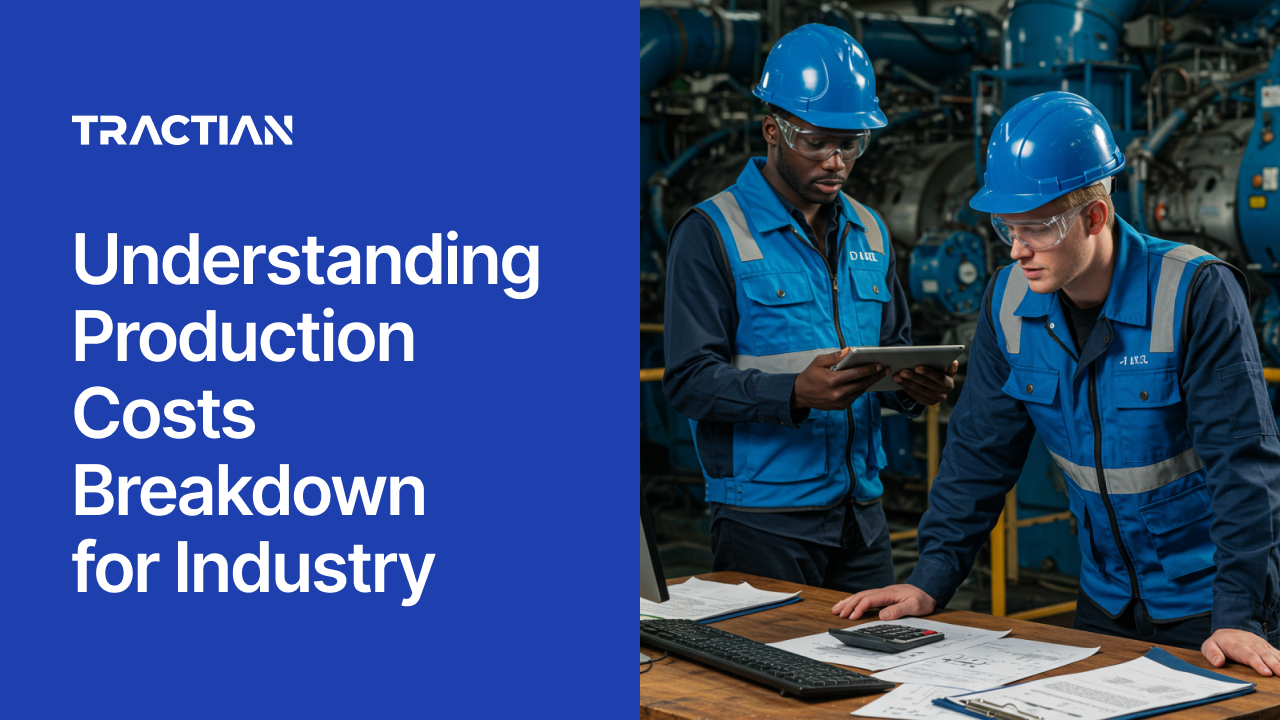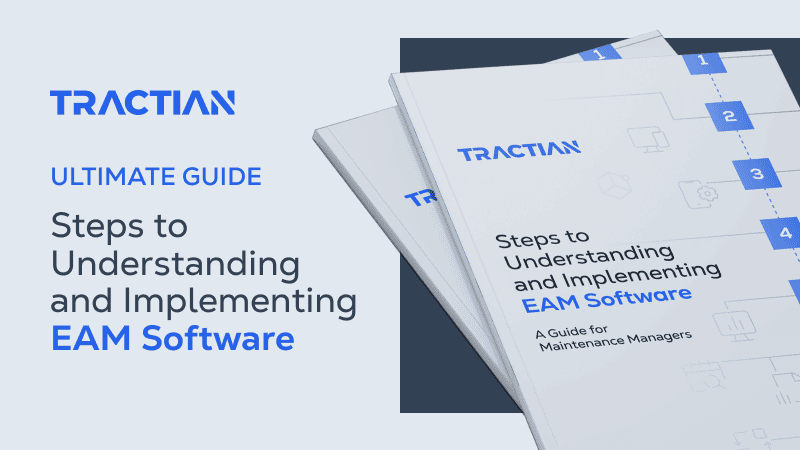Every operation runs on one key truth: if you can’t see your costs clearly, you can’t control them. And in industrial environments, where every hour of downtime or wasted material hits your margins hard, having that clarity isn’t optional.
Most teams track the basics: raw material invoices, labor hours, utility bills. But they still end up asking the same question every quarter: Where did our budget go? That’s because a big chunk of production costs hide in plain sight, scattered across departments, buried in outdated spreadsheets, or simply miscategorized.
In this guide, you’ll get a practical view of how production costs actually work on the plant floor, what’s driving them, and how you can bring them under control without sacrificing output.
What Is Considered Production Costs?
Production costs are everything it takes to turn raw inputs into finished outputs. That means materials, labor, energy, equipment wear, facility overhead, and every other hidden cost that stacks up quietly over time.
Figuring out production costs isn’t just about crunching numbers. When you know how much it really costs to make each unit, you can make smarter choices about pricing, where to put your resources, and how to improve your processes for better results. And if you’re not breaking those costs down with precision, you’re likely mispricing products, misallocating resources, or missing out on margin you could’ve protected.
At the core, “production costs” includes the raw materials that go into your products, the hands-on labor running the machines or assembling components, and the overhead required to keep the whole system running, like electricity, equipment depreciation, and maintenance. Each of these pieces contributes directly to your unit cost, and together, they determine whether you're running a lean, profitable line or bleeding cash without realizing it.
What matters most is understanding what drives these numbers, as well as how they shift over time, and where you can intervene without risking quality or uptime. Because when you know your real production cost per unit, that's when you can start optimizing.
Types of Production Costs and Examples
Not all production costs behave the same way. Some stay the same no matter how much you produce, while others rise and fall with output. That difference matters, especially when you’re forecasting budgets, scaling production, or trying to figure out why your margins are slipping.
To get a handle on what’s really driving your spending, you need to break costs into categories based on how they respond to change. That’s where the distinction between fixed and variable costs comes in.
Fixed Costs That Stay Constant
Fixed costs are the baseline. They don’t change when production ramps up or slows down. You pay them whether your plant is running full speed or sitting idle.
Think of things like facility rent, equipment leases, and salaried positions. These are long-term commitments baked into your monthly operating cost. Your CNC machine lease doesn’t disappear just because you’re producing fewer units this month. Neither does the insurance on your production line or the salary of your maintenance supervisor.
The upside is that fixed costs give you predictability. The downside is that, if you don’t produce enough to spread those costs across enough output, your per-unit cost balloons. That’s why understanding your cost structure is more than just helpful, it’s critical for staying competitive.
Variable Costs That Fluctuate
Variable costs are tied directly to how much you produce. More output means more material, more labor hours, and more utility usage. These are the costs that scale with your production line and that are often the easiest to track, but also the quickest to spiral if left unchecked.
Raw materials are the most obvious example. If you're manufacturing 1,000 units, you’ll need 1,000 sets of inputs like steel, plastic, chemicals, or whatever goes into your product. The same goes for direct labor: if your team is paid hourly and you extend a shift to meet a production goal, those labor costs go up. And don’t forget to calculate the energy usage tied to actual production. Running a furnace, powering a press, or operating a clean room all rack up additional costs when machines stay on longer.
But here’s where it gets tricky: variable costs aren’t always perfectly linear. Overtime wages can push labor costs higher than expected. Bulk purchasing might bring material costs down per unit. That’s why tracking these costs in real time, not just after the month closes, helps you respond quickly and keep profitability in check.
Direct vs. Indirect Cost
Costs that go straight to the product line are easy to trace, easy to justify, and tied to output. However, there are others that support the entire operation but don’t show up cleanly on a single unit’s price tag. Both of them matter. The key is knowing which is which so you can track them the right way.
Direct costs are the ones you can point to. If you're producing a part, direct costs include the raw materials that go into it and the labor tied specifically to assembling or machining that part. Even custom packaging or dedicated tooling for a product line counts here. It's simple: if it’s used for one thing only, it’s direct.
Indirect costs are everything else that keeps the operation moving but can’t be tied to a specific product. Think maintenance crews, quality assurance teams, utilities, and supervisors overseeing multiple lines. These costs need to be allocated, split across products based on logical drivers like machine hours or production volume.
Getting this split right is crucial because misclassifying indirect costs can distort your per-unit pricing, and underestimating their impact could leave you chasing “efficiency” in the wrong places.
Formula for Calculating Total Production Cost
If you want to control your production costs, you need to measure them with precision. And that starts with using the right formula.
At its core, the standard calculation looks like this:
Total Production Cost = Direct Materials + Direct Labor + Manufacturing Overhead
Each component plays a different role in your operation’s cost structure. Direct materials are the physical inputs, everything that becomes part of the final product. Direct labor covers the hands-on work from operators, assemblers, or machinists tied directly to production.
Then there’s manufacturing overhead. This is where most of the hidden costs live: utilities, maintenance, equipment depreciation, and indirect labor that keeps production moving behind the scenes. It’s often the hardest part to calculate, but also where the biggest gains (or losses) hide.
To get an accurate cost picture, break down each of these buckets. Total the material inputs per unit or batch. Multiply direct labor hours by wage rates, including benefits and payroll taxes. And allocate overhead based on logical drivers like machine hours or production volume.
Want a clearer view of your cost per unit? Divide the total production cost by the number of units produced in that period. Simple in concept, but game-changing when you apply it consistently, because the more precisely you measure cost, the more strategically you can cut it.
Production Cost vs Manufacturing Cost
These two terms may appear to be the same thing, but they aren’t. And in industrial environments, that difference affects everything from pricing to profitability.
Manufacturing costs are strictly tied to what happens on the shop floor. We’re talking direct materials, direct labor, and overhead. Basically, it's the cost of physically building a product.
Production costs, on the other hand, zoom out. They do include manufacturing costs but also account for what surrounds production: R&D, product design, process engineering, and even some distribution activities tied to execution. It’s the full cost of bringing a product to life, not just assembling it.
Why does this matter? Because using the wrong cost basis can distort your decision-making. Manufacturing costs are great for setting product prices or valuing inventory. But if you're analyzing total profitability or planning investments, production costs give you the full picture.
Product Costs vs Period Costs
In cost tracking, timing matters. That’s where the distinction between product and period costs comes in. It determines not just how expenses are classified, but when they hit your financial statements.
Product costs are directly linked to manufacturing. They include raw materials, labor tied to production, and overhead from the shop floor. These costs stay on the balance sheet as inventory assets. Once the product is sold, they move to the income statement under cost of goods sold.
Period costs, by contrast, are recognized immediately. They don’t depend on production volume or sales, they’re recorded in the period they occur. Expenses like office rent, executive salaries, sales commissions, and marketing fall into this category.
If you’re building a product, the material and assembly labor go into inventory as product costs. But the admin support or corporate overhead that keeps the business operating? That’s treated as a period expense.
Classifying costs correctly helps ensure your margins, reporting, and analysis reflect what’s really happening in the operation without muddying the numbers.
Practical Ways to Lower Production Costs
Cutting costs in manufacturing is about targeting waste, tightening workflows, and using resources where they’ll make the biggest impact. The goal isn’t just to spend less, but to spend smarter, without putting quality or uptime at risk.

1. Optimize Inventory Management
Inventory often ties up more capital than teams realize. Every part on the shelf carries hidden costs: storage space, insurance, depreciation, and the risk of obsolescence. And when inventory sits too long, those costs pile up fast.
That’s why dialing in your inventory turnover is one of the most effective ways to bring production costs down. Whether through just-in-time systems or material requirements planning, the aim is the same: keep enough stock to stay reliable, but not so much that it drags on your cash flow.
Reducing excess inventory also frees up space and simplifies storage. And when you build better relationships with suppliers, you can reduce lead times and negotiate better pricing, which further lowers your carrying cost per unit.
2. Improve Labor Scheduling and Efficiency
Labor is one of the largest recurring costs in production and one of the easiest to mismanage. Misaligned staffing leads to underutilized workers during slow periods and excessive overtime when demand spikes. Both eat into your margins.
Optimizing schedules to match production demand helps you stay lean without falling short. That might mean adjusting headcount by shift, or better yet, building flexibility into the team through cross-training. When technicians can move between roles or lines, you reduce the need for temps and overtime and get more output per labor hour.
Planning ahead also helps avoid the high price of reactive decisions. Overtime hours often cost 50% more, and the impact adds up fast. A well-structured shift plan lets you get ahead of bottlenecks, make better use of your workforce, and keep labor costs proportional to output.
3. Streamline Work Orders and Maintenance
Maintenance is a cost center, but it doesn’t have to be a black hole. Poorly managed work orders lead to delays, reactive repairs, and wasted labor. Clean up the process, and you start gaining back time, uptime, and budget.
Digitizing your work order flow removes the bottlenecks caused by paper trails and manual follow-ups. It ensures that priority tasks get scheduled and completed on time-especially for high-criticality equipment that can shut down entire lines when it fails.
Structured, digital workflows also make it easier to track actual time spent, spot recurring issues, and flag inefficiencies. Instead of chasing down updates or paperwork, your team stays focused on execution.
4. Implement Energy Efficiency Measures
Energy use is a silent cost driver, especially in high-consumption environments like metalworking, plastics, or food processing. In some plants, energy can account for up to 20% of total production costs, making it one of the biggest levers for savings.
Swapping outdated equipment for energy-efficient models cuts utility bills and often boosts performance at the same time. But the real gains come from control: automating systems to adjust energy usage in real-time based on what production actually requires.
Energy audits help pinpoint where waste is happening and where upgrades will pay off fastest. Even a basic tracking spreadsheet can reveal trends and flag outliers. And with many utilities offering rebates or tax credits for efficiency improvements, the return on investment isn’t just operational, it’s financial.
Tracking and Monitoring Costs in Industrial Settings
If you want to control costs, you need visibility. And real-time tracking isn’t a nice-to-have anymore. It’s a foundational tool for spotting inefficiencies, allocating resources, and staying ahead of waste before it impacts your margins.
Real-Time Data Collection Systems
Modern plants generate data by the second. The key is turning that data into cost insight.
IoT sensors track everything from equipment runtime and vibration to production throughput. That data feeds directly into your systems, giving you a live view of operational efficiency. Labor hours can be automatically logged through time tracking tools, with no more manual inputs, no more guesswork. Material usage can be digitally tracked down to the product and shift, replacing inconsistent inventory logs.
When you integrate these streams with your ERP, cost data flows across departments without bottlenecks. It’s a closed-loop system that strengthens both reporting and real-time decision-making.
Automated Cost Analysis Tools
Collecting data is step one. Analyzing it consistently is what drives real change.
Automated tools surface cost trends, outliers, and inefficiencies before they grow. Variance analysis highlights where actual spend is drifting from your targets. Cost driver tracking shows which areas are hitting your bottom line the hardest. And predictive models fed by historical and real-time inputs forecast future costs so you can act, not react.
The best part is that these tools work in the background, turning thousands of data points into decisions. That means fewer surprises, faster corrections, and a clearer path to cost control.
Integrated Scheduling and Planning
Disjointed schedules create bottlenecks, and bottlenecks cost money. When production, maintenance, labor, and materials aren’t moving in sync, delays stack up and efficiency takes a hit.
Integrated scheduling tools solve that by aligning every moving part. Production plans stay linked to actual capacity, minimizing idle time and improving throughput. Maintenance tasks are slotted into downtime windows, so preventive work doesn’t interrupt output or get skipped.
Labor scheduling also gets smarter. Instead of filling shifts reactively, you match skill sets to the tasks that matter most, keeping overtime in check and productivity high. On the material side, deliveries are timed to demand, cutting back on excess stock without risking shortages.
Using Technology to Reduce Production Costs
The reality is clear: controlling production costs starts with understanding them in full. That means moving beyond spreadsheets and estimates and getting granular with every factor: materials, labor, energy, downtime, and the gaps in between. Without that clarity, it's nearly impossible to make decisions that actually protect your margins.
But if you already deal with maintenance finances, you know these costs don’t live in one place. They’re spread across systems, buried in workflows, and often show up too late to act on. And for most teams, finding the time and tools to manage it all while still hitting production targets feels like a constant uphill climb.
That’s where Tractian’s CMMS changes the game. It puts cost control into your daily workflow, not just your quarterly reports. Through our platform, you get real-time insights into maintenance performance, asset condition, work order updates, and inventory usage, so you know exactly where your budget is going and what’s driving your unit costs.
Instead of chasing work orders or second-guessing spare part availability, your team works from a single, integrated system. Maintenance becomes structured, downtime becomes predictable, and your planning aligns with what’s actually happening on the shop floor.
And it doesn’t stop there. Tractian also gives you mobile access, intelligent scheduling, audit-ready reports, and automated cost tracking. Everything is built to help your team act faster, with fewer delays and more confidence.



